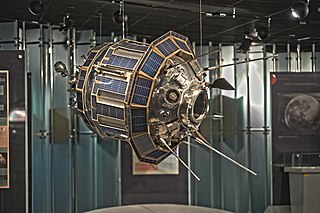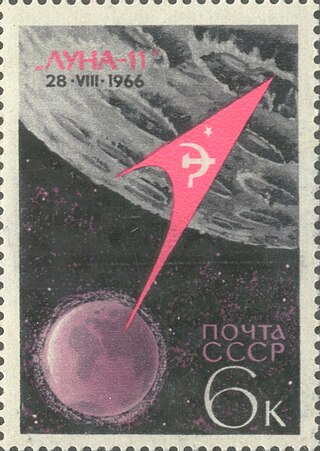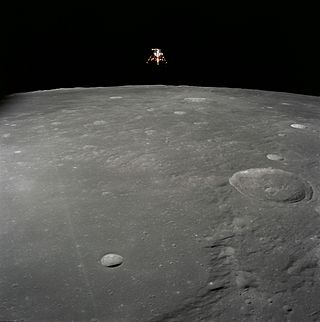
The Surveyor program was a NASA program that, from June 1966 through January 1968, sent seven robotic spacecraft to the surface of the Moon. Its primary goal was to demonstrate the feasibility of soft landings on the Moon. The Surveyor craft were the first American spacecraft to achieve soft landing on an extraterrestrial body. The missions called for the craft to travel directly to the Moon on an impact trajectory, a journey that lasted 63 to 65 hours, and ended with a deceleration of just over three minutes to a soft landing.

Surveyor 3 is the third lander of the American uncrewed Surveyor program sent to explore the surface of the Moon in 1967 and the second to successfully land. It was the first mission to carry a surface-soil sampling-scoop.

Luna 2, originally named the Second Soviet Cosmic Rocket and nicknamed Lunik 2 in contemporaneous media, was the sixth of the Soviet Union's Luna programme spacecraft launched to the Moon, E-1 No.7. It was the first spacecraft to reach the surface of the Moon, and the first human-made object to make contact with another celestial body.

Luna 3, or E-2A No.1, was a Soviet spacecraft launched in 1959 as part of the Luna programme. It was the first mission to photograph the far side of the Moon and the third Soviet space probe to be sent to the neighborhood of the Moon. The historic, never-before-seen views of the far side of the Moon caused excitement and interest when they were published around the world, and a tentative Atlas of the Far Side of the Moon was created from the pictures.

Surveyor 1 was the first lunar soft-lander in the uncrewed Surveyor program of the National Aeronautics and Space Administration. This lunar soft-lander gathered data about the lunar surface that would be needed for the crewed Apollo Moon landings that began in 1969. The successful soft landing of Surveyor 1 on the Ocean of Storms was the first by an American space probe on any extraterrestrial body, occurring on the first attempt and just four months after the first soft Moon landing by the Soviet Union's Luna 9 probe.

The Luna programme, occasionally called Lunik by western media, was a series of robotic spacecraft missions sent to the Moon by the Soviet Union between 1959 and 1976. The programme accomplished many firsts in space exploration, including first flyby of the Moon, first impact of the Moon and first photos of the far side of the Moon. Each mission was designed as either an orbiter or lander. They also performed many experiments, studying the Moon's chemical composition, gravity, temperature, and radiation.

Luna 9 (Луна-9), internal designation Ye-6 No.13, was an uncrewed space mission of the Soviet Union's Luna programme. On 3 February 1966, the Luna 9 spacecraft became the first spacecraft to achieve a soft landing on the Moon and return imagery from its surface.

Luna 11 was an uncrewed space mission of the Soviet Union's Luna program. It was also called Lunik 11. Luna 11 was launched towards the Moon onboard a Molniya-M and entered lunar orbit on 27 August 1966.

Luna 15 was a robotic space mission of the Soviet Luna programme, that was in lunar orbit together with the Apollo 11 Command module Columbia.

Luna 16 was an uncrewed 1970 space mission, part of the Soviet Luna program. It was the first robotic probe to land on the Moon and return a sample of lunar soil to Earth. The 101 grams sample was returned from Mare Fecunditatis. It represented the first successful lunar sample return mission by the Soviet Union and was the third lunar sample return mission overall.

Luna 17 was an uncrewed space mission of the Luna program, also called Lunik 17. It deployed the first robotic rover onto the surface of the Moon.

Luna 21 was an uncrewed space mission, and its spacecraft, of the Luna program, also called Lunik 21, in 1973. The spacecraft landed on the Moon and deployed the second Soviet lunar rover, Lunokhod 2. The primary objectives of the mission were to collect images of the lunar surface, examine ambient light levels to determine the feasibility of astronomical observations from the Moon, perform laser ranging experiments from Earth, observe solar X-rays, measure local magnetic fields, and study mechanical properties of the lunar surface material.

Luna 23 was an uncrewed space mission of the Luna program developed by the Soviet Union.

The Lunar Orbiter program was a series of five uncrewed lunar orbiter missions launched by the United States in 1966 and 1967. Intended to help select Apollo landing sites by mapping the Moon's surface, they provided the first photographs from lunar orbit and photographed both the Moon and Earth.

Zond 6 was a formal member of the Soviet Zond program, and an unpiloted version of the Soyuz 7K-L1 crewed Moon-flyby spacecraft. It was launched on a lunar flyby mission on November 10, 1968, from a parent satellite (68-101B) in Earth parking orbit. The spacecraft carried a biological payload of turtles, flies, and bacteria. It also carried scientific probes including cosmic ray, micrometeoroid detectors, and photographic equipment.

The 1966 Lunar Orbiter 1 robotic spacecraft mission, part of NASA's Lunar Orbiter program, was the first American spacecraft to orbit the Moon. It was designed primarily to photograph smooth areas of the lunar surface for selection and verification of safe landing sites for the Surveyor and Apollo missions. It was also equipped to collect selenodetic, radiation intensity, and micrometeoroid impact data.

The Lovell Telescope is a radio telescope at Jodrell Bank Observatory, near Goostrey, Cheshire, in the north-west of England. When construction was finished in 1957, the telescope was the largest steerable dish radio telescope in the world at 76.2 m (250 ft) in diameter; it is now the third-largest, after the Green Bank telescope in West Virginia, United States, and the Effelsberg telescope in Germany. It was originally known as the "250 ft telescope" or the Radio Telescope at Jodrell Bank, before becoming the Mark I telescope around 1961 when future telescopes were being discussed. It was renamed to the Lovell Telescope in 1987 after Sir Bernard Lovell, and became a Grade I listed building in 1988. The telescope forms part of the MERLIN and European VLBI Network arrays of radio telescopes.

A Moon landing or lunar landing is the arrival of a spacecraft on the surface of the Moon, including both crewed and robotic missions. The first human-made object to touch the Moon was Luna 2 in 1959.

The physical exploration of the Moon began when Luna 2, a space probe launched by the Soviet Union, made a deliberate impact on the surface of the Moon on September 14, 1959. Prior to that the only available means of lunar exploration had been observations from Earth. The invention of the optical telescope brought about the first leap in the quality of lunar observations. Galileo Galilei is generally credited as the first person to use a telescope for astronomical purposes, having made his own telescope in 1609, the mountains and craters on the lunar surface were among his first observations using it.

Third-party evidence for Apollo Moon landings is evidence, or analysis of evidence, about the Moon landings that does not come from either NASA or the U.S. government, or the Apollo Moon landing hoax theorists. This evidence provides independent confirmation of NASA's account of the six Apollo program Moon missions flown between 1969 and 1972.



















